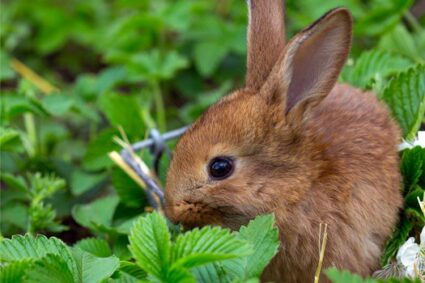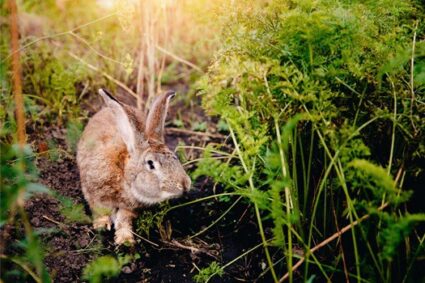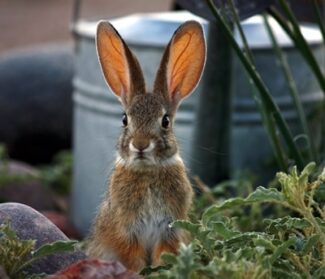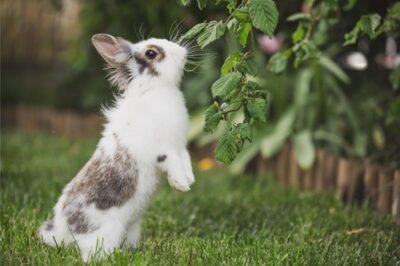Rabbits are voracious eaters, and their menu of favorite foods includes a wide range of plants. They can cause severe damage to young plants, shrubs, herbaceous plants, and flowers.
Rabbits sniff a lot, so put aromatic plants, shrubs, and flowers in your garden. Marigolds, alyssums, ageratum, snapdragons, catnip, and strawflowers are examples of plants that repel rabbits.
Understand that planting rabbit-repelling plants isn’t a guaranteed solution because hungry rabbits are likely to eat almost anything. However, filling your garden with a variety of these types of plants and flowers will make yours less appetizing to lagomorphs.
What Repels Rabbits from Eating Plants?
| Plant, Shrub or Flower | Why Do Rabbits Hate It? |
|---|---|
| Sweet Alyssum | – The strong, sweet fragrance |
| Ageratum | – Leaf texture – The fuzziness of the flowers |
| Lantana | – The strong scent from leaves – Toxic to rabbits |
| Pot Marigold | – Bitter taste and pungent odor |
| Wax Begonia | – Leaf texture and smell |
| Snapdragon | – Toxic to rabbits |
| Salvia | – Strong smell |
| Cleome | – Prickly stems and a strong odor |
| Globe Thistle | – Hairy stems and leaves |
| Catnip | – Strong fragrance |
| Peppers | – Spicy taste – Toxic leaves |
| Wormwood | – All parts of the plant are toxic |
| Geraniums | – Pungent smell |
| Potato | – Leaves are toxic |
| Strawflower | – Stiff and papery petals |
| Shirley Poppy | – Release a milky sap |
| Crown of Thorns | – Bears sharp thorns – Releases poisonous sap |
You might notice that rabbits twitch their noses a lot. This is because they’re always sniffing. They’re sniffing to find the right food, to keep away from poisonous plants and to steer clear of dangerous predators.
Planting perennials and annuals, such as alyssum, helps keep rabbits away from your garden. This is because certain plants have a strong fragrance. A smell that may be sweet or pleasing for humans, may be completely unappetizing for rabbits. Catnip is another excellent example of a rabbit-repelling fragrant plant.
Select plants that have strong scents, prickles, spines, and leathery leaves. Rabbits also avoid plants that are poisonous to them, or release toxic saps.
Flowers, Shrubs, or Plants That Rabbits Don’t Eat
Rabbits have food preferences based on the following factors:
- Taste
- Nutritive value
- Presence of prickles and poison
- Ease of availability
Their taste also varies by season and region. Therefore, not all plants are enjoyed by rabbits.
If a particular flower or shrub comes with spines, a strong odor or a strange, fuzzy texture, the chances are that rabbits will avoid it. The same goes for plants that ooze out toxic, milky saps.

Sweet Alyssum
Sweet alyssum or Lobularia maritima is a member of the mustard family that doesn’t only keep rabbits away, but is also easy to grow. In the spring, the plant carries numerous clusters of small white, violet, lavender or pink flowers. The flowers, as the name suggests, have a sweet and cheerful fragrance that humans love and rabbits hate.
Sweet alyssum can be grown in full sun or part shade and is hardy to both heat and drought. It’s an unmatched natural rabbit repellent that grows in almost any type of soil. The plant is richly concentrated in flowers with low growing foliage throughout its growing season. In warm climates, the blooms continue to grow year-round.
Sweet alyssum is a cool-weather flower that can be set out during early spring. You can start the flower from seed or plant. If you are starting with a plant, the good news is that the flower will self-sow and provide you with a yearly batch of gorgeous flowers. This is especially the case in milder climates.
Sweet alyssum seedlings are easily available in nurseries, typically in the fall and spring. Scatter the seed and press it down to allow enough contact with the soil. Make sure the seed is exposed to light at the same time.
Keep the soil moist until the seeds germinate. Following germination, you can water only when the soil feels dry. Once the plant is established, provide at least 1 inch of water every week. You’ll need to water more during dry or hot spells. The water should drain well or the plant is vulnerable to rot.
Surround the plants you’re trying to protect from rabbits with this plant. You can plant seeds outdoors, as soon as the soil feels warm to the touch, or you can start the seeds indoors.
Sweet alyssum will continue throughout fall and winter. Many varieties will deteriorate in the heat of the summer and bloom again in the fall.
Ageratum
Also known as floss flower, Ageratum houstonianum is among the few annuals that bloom in light shade. However, the plant does require at least 6 hours of sun every day. Blue is the most common color in the plant, but the flowers are available in pink and white as well.
What keeps rabbits away from ageratum are the fringes and fuzziness of the flowers, as well as the texture of the leaves.
Keeping the faded flowers trimmed back allows the plant to flower throughout early summer and fall.
Ageratum is a low-maintenance, low growing plant that is best planted at the edge of beds, borders, and walkways to keep rabbits away. Although they’re toxic to rabbits and deer, they do tend to attract many butterflies.
Ageratum is native to the American tropics and will not thrive beyond summer north of planting zone 10.
When planting blue ageratum, make sure the soil is well-drained, moist, and enriched with compost. Adding a layer of mulch will help control weeds and allow your soil to retain moisture.
Ageratums are versatile and aren’t picky about the pH of the soil. In the colder weather, the plants should receive full sun. In warm climates, the plant will benefit from some afternoon shade.
Plant ageratums in a well-ventilated flower bed. Doing so will keep spider mites and other pests at bay.
Lantana
The evergreen lantana plant bears clusters of flowers that resemble vibrant confetti. The flowers can be orange, yellow, red, purple or white, or a combination of these colors in a single cluster. The plant is of the broadleaf variety and is grown as annuals in the north. However, it can overwinter in southern regions.
The reviews on lantana’s rabbit-repelling abilities are mixed. While some gardeners claim that rabbits enjoy feasting on their lantana flowers, others suggest that rabbits avoid them because of the leaves’ potent smell.
The ripe berries and foliage of the plant also contain a toxin that can be harmful to many animals. Most often, rabbits know this and won’t attack the plant unless they’re very hungry. Most people have a distaste for the smell of lantana blooms, but the smell of the leaves allows it to be classified as a fragrant plant. The foliage has a pleasing, citrus-like scent.
Luckily, lantana doesn’t keep away all wildlife. Hummingbirds and butterflies adore this shrub.
Pot Marigold
Calendulas, also known as pot marigolds, or English marigolds are related to African and French marigolds. The bright orange and yellow flowers look similar to chrysanthemums and daisies.
They bloom from June and last until frost. If you live in an area with particularly hot summers, French marigolds are a more heat-resistant alternative with a longer bloom period.
Rabbits keep away from marigolds because of the plant’s bitter taste and pungent odor. However, note that marigold leaves and flowers are not toxic to rabbits and are still edible.
Wax Begonia
Like lantanas, begonias are annual flowers that keep some rabbits away. All rabbits are different and while some rabbits may dislike munching on begonias, others may enjoy snacking on them once in a while.
If you aren’t sure your neighborhood bunnies will steer clear of your begonias, try planting the flower in an area where rabbits are an issue. Do not plant an entire bed or row of these plants right away. Combine begonias with other rabbit-repelling plants and flowers to see what works best.
Wax begonias are easy-growing plants that can be grown in shade and sun. However, begonias do not enjoy the heat. Therefore, if you live in a hot climate region, shade your flowers from the sun.
Begonias are grown primarily for their foliage. Begonia flowers are small and less showy. Therefore, gardeners often remove the blooms to maintain the plant’s stunning leaf displays. Wax begonia leaves range from green to gorgeous shades of purple, bronze, and maroon.

Snapdragon
Snapdragon flowers are enjoyed for their resemblance to a dragon’s face that opens and closes when squeezed laterally. This feature makes the tiny flowers incredibly enjoyable to children and even adults. However, rabbits cannot stand them.
In fact, many parts of Antirrhinum (snapdragon) are toxic to rabbits and should never be grown if you have them as pets.
Native to the rocky areas of the United States, Europe, and North Africa, this plant ranges from dwarfs to giants that grow 3-4 feet tall. Therefore, there is a suitable size for any sunny space in your garden. Keeping the flowers deadheaded will encourage continuous blooms.
Snapdragons are typically grown as annuals. If they do overwinter, they won’t bloom as vigorously as they did during their first year. The flowers should form seed pods in the first year and may even self-sow if you’re lucky.
Snapdragons will continue to bloom in partial shade to full sun during springtime. As the temperature rises, your snapdragons may stop blooming. To prolong the blooms until fall, consider planting them in partial shade and offering plenty of water throughout the summer.
However, snapdragons are quick to establish and can be easily replaced every season.
Although snapdragons are mostly pest and disease-resistant, wet seasons can make them vulnerable to rust and other fungal diseases. If you live in a damp area, search for more resistant varieties of snapdragon plants.
Salvia
Salvia flowers are attractive to butterflies and hummingbirds, but not to rabbits and deer. Rabbits keep away from this plant primarily because of its strong aroma.
Depending on the type, salvia blooms can be lavender, red, purple, blue, pink, orange or cream.
Salvia is a drought-resistant perennial and grows best in an area with full sun. In warmer climates, they can thrive in partial shade. Make sure the flowers are grown in well-drained soil and take particular care of young plants that require sufficient irrigation.
Cleome
Also known as spider flowers, cleome is a less popular annual sold at nurseries and home improvement stores. This is largely because of its weedy look. However, the flower’s prickly stems and strong odor does an effective job in preventing rabbits from eating your plants.
When it comes to its scent, some suggest that the plant smells minty, while others may complain about its catty, or skunk-like odor.
Cleomes are indigenous to the southern United States and South America and bear large flower clusters from summer until frost.
Unlike marigolds and cleomes do not bloom until they are well-established in their growing space. However, once the flowers emerge, they require very little care.
Globe Thistle
Globe thistle, or Echinops, is a contemporary-looking flower with furry gray stems and remarkable spiny, gray-green leaves. Rabbits tend to avoid these flowers because of their hairy stems and leaves.
Globe thistle blooms and leaves last for a long time and make perfect candidates for a cut flower garden. They’re also deer and drought resistant. However, their nectar attracts many bees and butterflies.
In addition to keeping away rabbits, the spiky leaves also serve as a source of food for butterflies. As the blooming period nears its end, the flowers continue to add textural interest to your garden with their impressive seed heads.
Catnip
Cats love nibbling on catnip, also known as catmint, but rabbits cannot tolerate the plant’s powerful fragrance. The plant begins blooming lavender blue later in the spring and continues to grow until frost. For most people, catnip adds a heavenly smell to any garden. It smells lovely, especially when you brush past the plant.
Catnip can be planted from seeds or plants, during springtime or fall. The plant will sprout within 2-3 weeks if you’re starting from seed. Catnip has featherlike, green foliage, which may be another factor that deters rabbits.
In addition to keeping rabbits at bay, you can also grow catnip to use in your salads and as herbal remedies. Tea made with catnip leaves and flowers can help relieve coughs. According to research published in Vectors of Diseases, the oil extracted from the plant can be used as a natural mosquito repellent.
Therefore, if you’re looking for a multipurpose plant to add to your garden, catnip may be a fabulous contender.
Peppers
Rabbits tend to avoid peppers because of their spicy scent and taste, as well as their toxic leaves.
To keep rabbits away, remember the spicier the pepper, the better. Choose hot peppers such as jalapeno peppers or red hot chili peppers as they are easy to grow and can be incorporated in many dishes.
Peppers are often grown outside during spring and summer. However, they can also be grown indoors if the weather isn’t suitable. Most pepper varieties need full sun to develop flavor and heat. Both factors, and color, will change as the pepper ripens. If you’re looking for a fiery pepper, consider reducing watering by half.
Wormwood
Artemisia, or wormwood, is generally fancied for its fragrant, silver leaves. The plant is excellent at keeping rabbits away because each part of the plant is toxic. However, if you have children or outdoor-access pets, growing this plant is not recommended due to its poisonous nature.
Native to Japan, wormwood thrives in zones 3 through 7, which includes almost all of the United States, except Hawaii.
Wormwood is an unusual perennial that is grown solely for its foliage. The flowers do not amount to much and can be ignored. What’s strange about this plant that it asks for something that kills most plants: non-fertile soil. Although a little bit of enrichment will not harm the plant, what will hurt it is soil that isn’t well-drained.
Wormwood is a ground cover plant that enjoys full sun. Be sure to water moderately to allow young plants to establish themselves. Once the plants are established, they need much less water than an average garden plant.

Geraniums
Geraniums are effective natural rabbit-repellents because of their pungent smell. Although rabbits hate their smell, gardeners enjoy varieties with rose, citrus, and other pleasant fragrances.
Geraniums are best grown in full sun. Continue removing faded flowers to encourage new blooms. Many gardeners like to bring their geraniums indoors to overwinter. The plant will continue to grow flowers as long as it gets enough sun.
Potato Plant
Potatoes are a high-starch food for rabbits, but they aren’t poisonous. Their leaves, flowers, and vines, however, are highly toxic to rabbits. The same goes for other plants from the nightshade family, including tomatoes, eggplant, peppers, tomatillos, and goji berries.
Potato plants don’t have a special fragrance that deters rabbits. Rabbits are quick to learn from senior members of their warren on which plants are safe for consumption, and which ones aren’t.
Potatoes can be grown from special seed potatoes, also called tubers. They look exactly like supermarket potatoes, but they’re certified virus-free. You can buy seed potatoes from late winter onwards and start them off indoors before planting them outside.
Do Rabbits Eat Sweet Potato Leaves?
Although sweet potatoes have the word potato in their name, they aren’t even closely related to regular potatoes. They aren’t genetically similar and come from different families.
So can sweet potato foliage keep rabbits away? Sweet potato plants aren’t nightshades and thus aren’t poisonous to rabbits. According to research published in the Texas A&M University, rabbits can eat the vines and leaves of sweet potatoes without any ill effects.
Therefore, if you’re trying to grow a rabbit-repellent plant, regular potatoes are much more effective.
Strawflower
Strawflowers are grown as short-lived perennials in zones 8 through 11 and are considered as annuals in other parts of the United States.
Strawflowers resemble daisies due to their stiff petals. However, these petals are actually modified leaves called bracts. They aren’t true petals, and rabbits particularly dislike their stiff and papery texture.
The flowers come in orange, yellow, cream, white and multiple shades or purple and pink. They thrive well in sandy and rocky soils, compared to rich, fertile grounds. Strawflowers primarily need well-drained soil and full sun to survive.
Shirley Poppy
Shirley poppies have a strong aroma and release a milky sap that does a great job of preventing rabbits from eating them. Often referred to as field poppies, corn poppies, or Flanders poppies, these flowers thrive in cool climates and give into humidity and heat. Shirley poppies are delicate-looking flowers that often come in orange, yellow, white, red and violet. They’re also adorned by beautiful gray-green foliage.
Plant Shirley poppies in full sun and provide the plants with rich, well-drained soil. Doing so will ensure that they bloom every summer.
Crown of Thorns
Euphorbia milii, or crown of thorns gives gardeners the most bang for their buck when it comes to repelling rabbits and other pests. The plant has spiny branches and stems, and releases a sap that repels rabbits. The sap can be toxic to rabbits and most other animals.
Crown of thorns an evergreen perennial shrub that is indigenous to Madagascar. It thrives in zones 10 to 11, but many cooler zone gardeners may use it as a patio plant or a houseplant.
The better the sun exposure, the more blooms you will get with this plant. The plant is sure to bloom as long as it gets 3 to 4 hours of bright, direct sunlight every day. The plant blooms almost year-round and is a pretty succulent that can be used to surround your vegetable garden to keep away rabbits.
Caution: Crown of thorns has sharp black thorns on its stems and main branches. Furthermore, it releases a sticky, latex sap when its leaves or stems are broken. This sap is toxic to humans and pets when ingested and can cause eye and skin irritation when touched.
Why Should You Keep Rabbits Away?
Anyone who maintains a garden considers rabbits as more than just an adorable threat to their veggie patch. Rabbits have voracious appetites and are notorious for destroying many kinds of fresh vegetation, from woody plants to annuals, perennials, berries, and veggies.
Rabbits can eat such a wide range of vegetation that it is easier to list the plants they don’t enjoy or like to keep away from.
Rabbits are also known for their high reproductive potential. Therefore, allowing them to snack around in your garden can lead to a massive backyard infestation. Rabbits can produce up to three litters of six kittens per year in the north, and up to six litters or three kittens per year in the south. The first litter comes in March in the north and throughout the year in other regions.
What’s worse (for you, the gardener) is that when provided ideal living conditions, with ample food and nourishment, rabbits are likely to reproduce more.
Furthermore, your backyard rabbit’s primary concern is to eat without the risk of being hunted by a predator. Rabbits are at the bottom of the food chain, with grass being the only thing beneath them. Therefore, nibbling on your lettuce patch may not be a carefree mission for a wild rabbit, unless it can squeeze through a tiny hole in your fence.
Your primary focus should be to protect those plants that you and wild rabbits love. Rabbits have sensitive noses, so a combination of repellents, such as rabbit-repelling plants and natural deterrents, such as chili powder and blood meal often does the trick.
When coming up with plants to surround your veggie and flower patches, choose varieties with strong scents, especially those with herbaceous, earthy aromas. These don’t often pass a rabbit’s smell test.
How To Detect Rabbit Damage
Rabbits are insatiable eaters, so they will leave clean-cut damage to your crops. Look for leaves and stems with cleanly cut damage. Insects and other pests often leave jagged edges on the plants they’ve harmed.
The clean-cut damage caused by rabbits generally occurs at ground level. Rabbits will often nibble at the delicious green shoots of your veggies, tulips and other plants. Gardeners and farmers find rabbits menacing mainly because they tend to eat away the first tender young shoots, cropping them short.
Rabbits also enjoy munching on peas, lettuce, beans, a wide array of flowers, clover and much more. Note that groundhogs and woodchucks also eat these plants, so look out for any burrows before deciding you have a rabbit issue.
In most cases, plants that have passed the seedling stage are safe from rabbit damage. Therefore, you should prioritize protecting seedlings and young plants from wild rabbits.
If a particular plant shows no sign of damage even if you have a rabbit problem, chances are your neighborhood rabbits aren’t a fan of this plant. You’re better off focusing on plants that require more protection than plants that don’t interest wild rabbits and other pests.


Last year the wild rabbit that roams my yard ate ALL of my marigolds that I planted around my vegetable garden (to deter pests) right down to the ground every day as well as my neighbor’s. Also ate my wax begonia and my miniature snapdragons. Demolished my Italian oregano…totally killed it and nibbled on my catnip. I’ve never known of any animal that eats marigolds. This critter loves them. Only left them alone when I sprinkled them with cayenne, but went right back after it washed away. Even put wood skewers, point end up, and it nibbled around them.
The rabbits have eaten everything in my yard too. The Holly, Barberry, Spirea, Roses they love anything woody. Every year I replace and they eat I’m at the point of buying some decorative rocks. The rabbits have won!